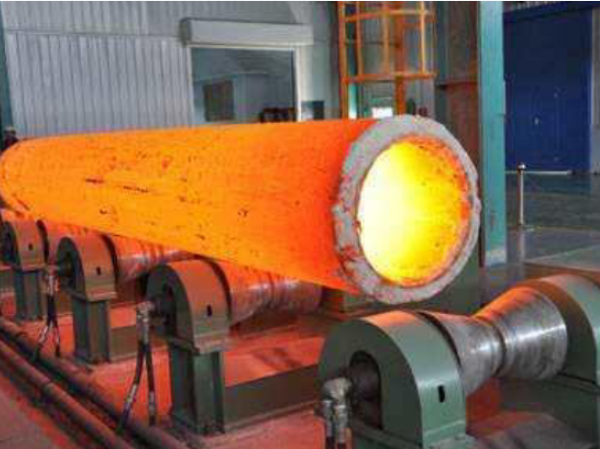Normalizing process of
seamless carbon steel pipe
Normalizing, also known as normalizing, is to heat the workpiece to Ac3 (Ac refers to the final temperature at which free ferrite is completely transformed into austenite when heated, generally between 727°C and 912°C) or Acm (Acm is in the actual medium Heating, the critical temperature line of complete austenitization of hypereutectoid steel is above 30~50°C, after holding for a period of time, take it out of the furnace for air cooling or water spraying, metal spraying heat treatment, the purpose is to refine the grains of normalizing and annealing The difference is that the cooling rate of normalizing is slightly faster than that of annealing, so the structure of normalizing is finer than that of annealing, and its mechanical properties are also good. In addition, the external cooling of normalizing furnace does not occupy equipment, and the productivity is high, so try to use normalizing furnace instead in production Annealing, for important forgings with complex shapes, high temperature tempering (550-650°C) is required after normalization. The purpose of high temperature tempering is to eliminate the stress generated during normalizing cooling and improve toughness and plasticity.

The main application areas of normalization are:
①For low carbon steel, the hardness after normalizing is slightly higher than that after annealing, and the toughness is also better, so it can be used as pre-cutting treatment.
②For medium carbon steel, it can replace quenching and tempering treatment (quenching + high temperature tempering) as the final heat treatment, and can also be used as a preparatory treatment before induction heating surface quenching.
③Used in tool steel, bearing steel, carburizing steel, etc., it can reduce or inhibit the formation of network carbides, so as to obtain the good structure required for spheroidizing annealing.
④ For steel castings, it can refine the as-cast structure and improve the machining performance.
⑤For large forgings, it can be used as final heat treatment to avoid large crack tendency during quenching.
⑥Used in nodular cast iron to improve hardness, strength and wear resistance, such as manufacturing important parts such as crankshafts and connecting rods of automobiles, tractors and diesel engines.
⑦ Carry out normalizing once before hypereutectoid steel spheroidizing annealing to eliminate reticular cementite and ensure that all cementite is spheroidized during spheroidizing annealing.
Microstructure after normalizing: hypoeutectoid steel is ferrite + pearlite, eutectoid steel is pearlite, hypereutectoid steel is pearlite + secondary cementite, and is discontinuous.
Normalizing is mainly used in the production of steel workpieces, such as
seamless pipes (SMLS). Generally speaking, normalizing steel is similar to annealing, except that the cooling rate is slightly larger and the structure is finer. Some steels with a small critical cooling rate can be air-cooled to transform austenite into martensite. This treatment is not a normalizing property, but is called air quenching. In contrast, some large-section workpieces made of steel with a large critical cooling rate cannot obtain martensite even if water quenching is performed, and the quenching effect is close to normalizing. The hardness of the steel after normalizing is higher than that after annealing. During normalizing, the workpiece does not need to be cooled with the furnace like annealing, so the time in the furnace is short and the production efficiency is high. Therefore, normalizing is generally used instead of annealing in production.
For low-carbon steel with a carbon content of less than 0.25%, the hardness after normalizing is moderate, and it is easier to cut than annealing. Normalizing is generally used to prepare for cutting.
For medium carbon steel with a carbon content of 0.25-0.5%, it can also meet the cutting requirements after normalizing. Normalizing can also be used as a final heat treatment for lightly loaded parts made of this type of steel. The normalizing of high carbon tool steel and bearing steel is to eliminate the network carbide in the organization and prepare the organization for spheroidizing annealing.
For the final heat treatment of ordinary structural parts, since the comprehensive mechanical properties of the workpiece after normalizing are better than the annealed state, for some ordinary structural parts with small stress and low performance requirements, normalizing can be used as the final heat treatment to reduce the number of processes and save energy. energy and increase production efficiency. In addition, for some large or complex parts, when there is a risk of cracking during quenching, normalizing can often be used instead of quenching and tempering as the final heat treatment.













 Eastern Steel Manufacturing Co.,Ltd not only improve product production and sales services, but also provide additional value-added services. As long as you need, we can complete your specific needs together.
Eastern Steel Manufacturing Co.,Ltd not only improve product production and sales services, but also provide additional value-added services. As long as you need, we can complete your specific needs together.










